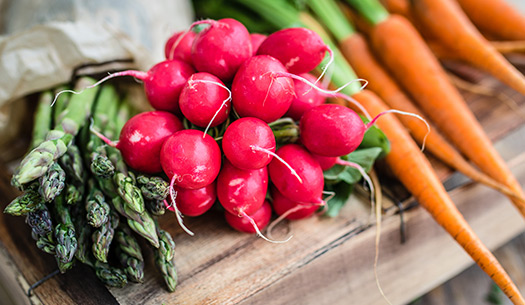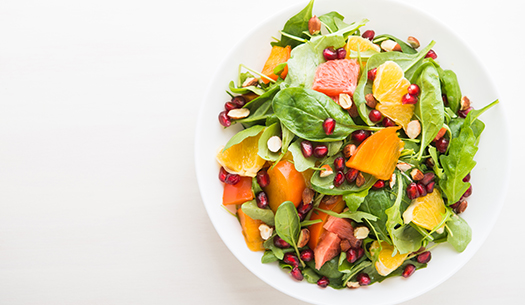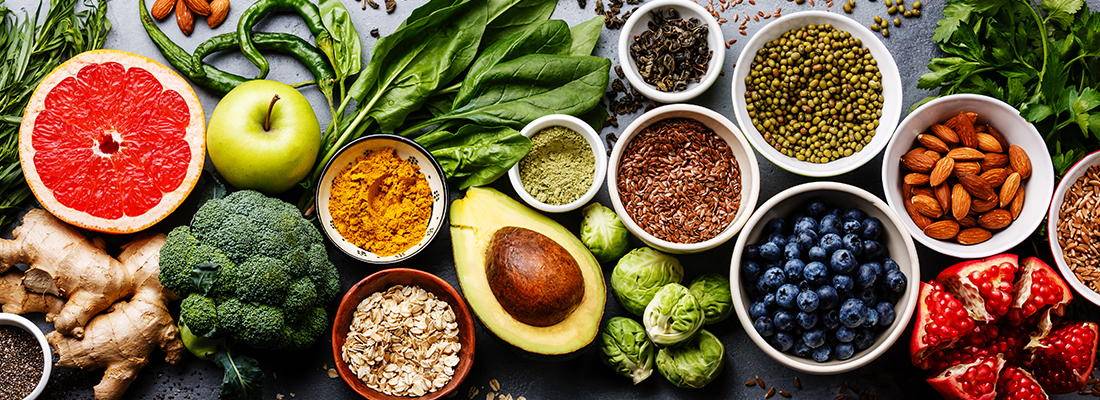
Bite into spring
With the days getting warmer, you’re getting ready to break out the patio furniture. It’s also time to welcome a new crop of seasonal fruits and vegetables!
Green, white, and purple asparagus (May and June)
Eat them grilled or blanched (but still firm) with pasta tossed with lemon and cream cheese, in a salad or on focaccia with mushrooms and a sprinkle of Parmesan.
Store them by wrapping the spears in a plastic bag and placing them in the vegetable crisper. Eat asparagus within 7–10 days after you buy it.
Good to know: To quickly remove the tough stems from a bunch of asparagus, simply take each spear by the middle in one hand, grab the end with your other hand, and bend: the stem will snap in the right spot.
Radishes (March to June)
Eat them…
- As chips: Thinly slice and place on a baking sheet covered with parchment paper. Coat with olive oil, sprinkle with fresh thyme, salt, and pepper, and bake for 15 minutes on each side.
- Pickled: Thinly slice, then let sit for 2–3 hours in a mixture of vinegar, sugar, oregano, and coriander seeds, then add them to your tacos, Buddha bowls or avocado toast. (Psst! Pickled radishes also taste great with smoked salmon.)
Store in the refrigerator in a plastic bag for up to 5 days after removing the leaves.
Good to know: Have your radishes gone soft? Submerge them in ice water for a few minutes and they’ll regain their crunch. (Don’t leave them too long, though, or they may lose their flavour!)
Rhubarb (April to July)
Eat it…
- In a compote: Clean off the dirt and remove the leaves, then chop the stems and place them in a microwave-safe container with a few spoonfuls of water (not too much!), a little brown sugar, and a few drops of vanilla extract. Cook for 3–4 minutes, and voilà!
- In savoury dishes: Cooked, sliced, and slightly sweetened rhubarb tastes great in curry, salsa and chutney recipes. It also goes perfectly with chicken.
Store for a few days in the refrigerator, or freeze the stems after slicing them.
Good to know: Only the stems of rhubarb are safe to eat. If they’re tough, try removing the outer layer with a vegetable peeler.

Get a fresh taste of summer
Garden-fresh summer veggies, herbs, and berries are ideal for delicious crudités, snacks, and desserts. (Who can say no to a bowl of strawberries served with whipped topping or ice cream?) But that’s not all that summer’s bounty has to offer!
Melons (July to September)
Eat them plain, with a little basil, or…
- Try a cantaloupe, tomato, mango, and cucumber salsa with a dash of lime juice and jalapeño.
- Puree cubed honeydew melon in a food processor with some cucumber, celery, yogurt, and mint for a cold soup.
- Add thin slices of watermelon to your burgers or sandwiches. It’s delicious with tzatziki, oregano, and lemon juice!
Store melons for about 6 days in the crisper drawer of your refrigerator. Since their odour permeates other foods, it’s a good idea to wrap them in plastic wrap or store slices in an airtight container.
Good to know: Look for heavier melons with a soft rind. The stronger the scent, the riper the fruit.
Stone fruits (June to October, depending on the variety)
Eat them in savoury dishes! Nectarine slices add a tangy touch to fresh mozzarella and dry-cured ham sandwiches, and roasted peaches or plums pair beautifully with meat. (Of course, stone fruits are just as tempting in desserts: What better way to end a meal than an apricot tart with a creamy cheese filling?)
Store them in a cool, dry place, but keep them out of the refrigerator to preserve their flavour and texture.
Good to know: If possible, smell your peaches and nectarines before adding them to your cart. The best ones are fragrant with soft flesh and no blemishes.

Beets (May to September)
Eat them in a sorbet with pomegranate juice and a little maple syrup, or sliced thinly on a platter with red grapes, hazelnuts, and arugula drizzled with oil and topped with a bit of fresh rosemary.
Store them for 5 days in the crisper drawer of your refrigerator. Be sure to remove the tops before storing, and keep them in an airtight container or paper bag.
Good to know: If your beets are showing signs of drying out, try to eat them as soon as possible!
Fall is apple season—but don’t forget about squash!
You know all about compotes, crumbles, and soups. But what if you took fall cooking in a new direction with seasonal fruits and vegetables?
Apples (end of August to end of November, depending on the variety)
Eat them in salads, tossed with kohlrabi, Parmesan cheese, and white wine vinegar, or make a sauce for white meats by mixing cooked apple cubes with cider, butter, and flat-leaf parsley. Do you have a sweet tooth? Prepare an apple and maple tart. There are 12 varieties of apples in Quebec; you’re sure to find one that suits your dishes!
Store them for a few weeks to a few months in the fruit drawer of your refrigerator after taking them out of their bag or container.
Good to know: Do you throw away your apple peels? Not so fast! When washed and steeped in boiling water with a cinnamon stick and a few cloves, they make the perfect tea for fall.
Squash (October to January)
Eat them…
- In macaroni and cheese: Stir a mixture of grated Parmesan, cheddar, and mozzarella into warm butternut squash puree to make a creamy pasta sauce.
- In ravioli: Place a dollop of pumpkin puree, along with a pinch of salt and pepper, in the centre of pasta squares cut from fresh lasagna dough. Fold and pinch closed, then boil for a few minutes and enjoy with toasted hazelnuts, sun-dried tomatoes, and your favourite cheese.
Store at room temperature for about a week.
Good to know: Pumpkin seeds are delicious when roasted with a touch of soy sauce!

Brighten up your winter
Tired of having grapefruit for breakfast, clementines for a snack, and stews for dinner?
Citrus fruits (December to March)
Eat them in seafood dishes (salmon steak, shrimp stir-fry or salad, pan-fried scallops), zested over pasta, or supremed and sprinkled with oil and Indian-style spices.
Store them in the refrigerator once they have ripened at room temperature.
Good to know: A ripe citrus fruit is relatively heavy because of the juice it contains. The best way to figure out when to refrigerate it is to weigh the fruit.
Root vegetables
Eat them…
- As fries: Cut salsify, sweet potatoes, or rutabagas into julienne strips, coat them with olive oil, sprinkle with sea salt and your favourite spices, and then bake for about 25 minutes.
- In a gratin: Simply combine slices of Jerusalem artichoke with 35% cream and cheddar or Gouda cheese and pop in the oven for 45 minutes!
- In a casserole: Update traditional shepherd’s pie by replacing the potatoes with mashed turnips, sweet potatoes, and carrots and swapping out the meat for a mixture of quinoa, lentils, and onions braised in red wine.
Store them for 1–2 weeks at room temperature.
Good to know: Rich in fibre, potassium, and vitamins B and C, root vegetables are a delicious way to eat healthy all winter long.
Try a new ingredient (and learn how to prepare it)!
Do you ever walk by a vegetable display at the grocery store and think, “I’d buy them if I only knew how to cook them”? We’re taking the mystery out of 4 local vegetables!
- When preparing fiddleheads, make sure they’re tightly rolled, remove the scales and brown ends, and rinse them under the tap for a few minutes. Cook them in boiling water for 15 minutes before adding them to your salads and omelets, or sauté them in a pan!
- To prepare an artichoke, remove any damaged leaves near the stem, then cut off the stem, the head, and the tough tips of the leaves. Place the trimmed artichoke in a saucepan with olive oil, lemon juice, and garlic and fill with water until it’s half covered. Boil until tender.
- Swiss chard is a delicious addition to a stir-fry, bibimbap, or salad. The best part is that you can use both the stems and the leaves. Simply wash, then chop.
- Once peeled, kohlrabi can be grated and eaten as a salad, cubed and roasted, or added to a soup. The options are endless!
Fruit, veggies, and BBQ: A smoking-hot trio
BBQ gives you lots of options for preparing quick and easy and vegetable and fruit dishes: it’s a great way to add variety to your plate and keep summer flavours alive all year round.
For vegetables, papillotes are a classic. But why not add these ideas to your repertoire?
- Spread pesto on slices of zucchini, throw them on the grill, top with grated Parmesan once they’re cooked through, and garnish with walnuts.
- Grill cremini mushroom skewers or portobello mushrooms marinated in a mixture of olive oil, balsamic vinegar, soy sauce, and garlic. If you’re looking for a vegetarian burger option, this is a tasty alternative to meat patties.
- Scoop out your peppers, then fill with a mixture of eggs, cheddar, and chives before grilling—perfect for brunch!
- Grill corn on the cob (with or without the husk) topped with queso fresco (fresh cottage cheese), chopped cilantro, and a squeeze of lime juice. Other ideas: Add roasted corn kernels to a Mexican sauté or toss them with diced peppers, tomatoes, and onion in a tortilla.
You can also grill many types of fruit on your barbecue. Never tried it? Here are a few ideas to get you started:
- Caramelize pineapple slices with honey or maple syrup, sprinkle with cinnamon, and serve with cream.
- Make a warm appetizer by lightly grilling skewers of strawberries and serving with a balsamic reduction and fresh basil, or make strawberry papillotes by combining them with orange zest and cardamom. Take a spoonful of plain yogurt, add a little melted dark chocolate, and you have a delicious and healthy dessert!
- Brush peaches with olive oil or barbecue sauce, grill, and serve warm on their own or in a salad with haloumi cheese, honey, thyme, and a touch of lemon.
If you don’t have a barbecue or save yours for the end of summer, you can always grill dishes in the oven. Whatever the season, your Marché Richelieu has the ingredients you need.
Marché Richelieu, your everyday partner!
Eating seasonal fruits and vegetables is a great way to cook healthy meals on a budget and buy groceries without emptying your wallet. (Nobody’s saying you can’t pair your dishes with a good beer or wine from time to time—moderation is the key!)
There’s no shortage of options at Marché Richelieu. Read our flyer to make sure you don’t miss out on our best deals!


